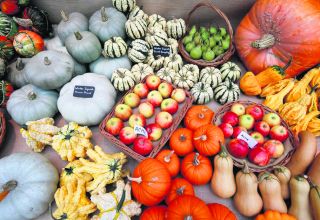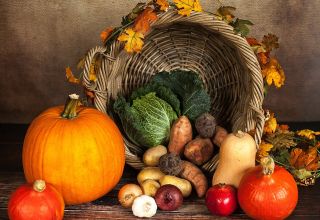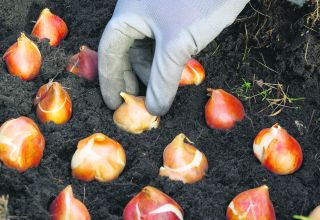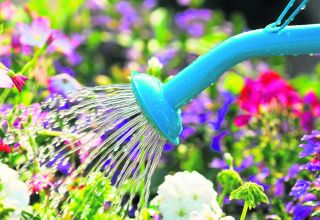September is the beginning of one of the favourite times of year for lots of gardeners, not least for the fact that the garden is more relaxed than it has been for some time. The fight to keep your plants watered or producing or deadheaded has eased and a new wave of tasks is awaiting – even thoughts of next spring!
Autumn feed boost for parched lawns
After a long, dry summer, lawns will appreciate an organic, slow-release autumn feed but wait until the ground is moist and growth has started again. With the cooler evenings and autumn rain, mould and fungus are more likely. Keep picking the dahlias to avoid damping off and cut the majority of foliage out of tomato vines. This will allow air and light to the fruit, prevent them from rotting and promote ripening. If you grow grapes, pick the fruit before botrytis gets to it.
Hunt out those yellow leaves on your roses!
Even the healthiest roses will have some old, tired leaves now. Get rid of yellow and diseased leaves and your plants will look better instantly. They are very easy to remove, just pull down on the leaf stem and it will easily break away from the main stem of the plant. Pull off yellowing and diseased leaves and snip off any that are surrounded by healthy leaves. Put them in the bin, then stand back and admire a healthy lush green plant that can still have more flowers to come.
Time to lift and divide
Summer-flowering herbaceous perennials can be lifted and divided in September when they’ve finished flowering, but the soil is still warm enough to aid new root development.
In fact, most perennials need to be divided every two to three years, otherwise they get too big for the space they’re in and become congested. Dividing your perennials will, of course, also increase your plant stock for free!
To do it, gently dig out the plant you wish to divide. This is often best done with a fork rather than a spade, as the latter is more likely to sever plant roots. Once the plant is out, divide it in a way suitable to its type. Small fibrous-rooted plants like hostas, heuchera and epimediums can be gently teased into two with your fingers, while larger fibrous-rooted varieties, such as hardy pelargoniums and hemerocallis are best levered apart using two garden forks thrust back to back into the plant’s centre. This will separate the plant into two with minimal root damage. If the plant you’re dividing is especially big, you will need a good strong fork.
Plants that have woody crowns or fleshy roots, such as astrantia delphinium or helleborus usually need chopping in two with a spade or saw. So there’s no need to be shy with these varieties.
Once the plant has been divided, replant the newly divided specimens in your chosen spots and remember to water them frequently as they get established. They should have enough time to set root before dying back for winter, ready to burst into life again next spring.
Propagate tender perennials by taking cuttings
Tender perennials like fuchsia, petunia, salvia (sage), verbena (vervain), penstemon and chrysanthemum can all be propagated with cuttings. This is a brilliant way to grow more plants for nothing, and there’s something satisfying about nursing plants through from tender young shoots to fully-fledged plants for use in your own containers.
You’ll need to find strong, young growth that hasn’t flowered this year and snip it off at an angle just beneath a leaf joint, leaving a stem of about six centimetres in length. Next, strip off the leaves from the lower stem, leaving just one or two pairs towards the top. This will help to prevent the plant from losing too much water via its leaves while it has no roots to take moisture up from the soil.
Dip the end of the cutting in hormone rooting powder and plant in compost mixed with a little horticultural grit for drainage. This will help to prevent the end from rotting and promote good root growth.
It’s harvest time
When the leaves of your onions begin to flop over, they’re ready to harvest. Check them and use any with signs of damage first. Then the rest of the crop can be stored in old net bags, plant trays or even plaited into strings. Pumpkins and squash should be raised off the ground to ripen in the sun before harvesting. If the weather is wet, cut them early and bring them in to ripen in a greenhouse or sunny windowsill. To cure the fruits for storage, keep them in a warm room for a fortnight, then put them somewhere dry and cool but frost-free. Early varieties of apples, such as ‘Discovery’, are best picked and eaten as soon as they’re ripe.
You can tell when an apple is ready by gently cupping the fruit in your hand and twisting. If it comes away, it’s ready.
This month is perfect for planting spring bulbs
September is the perfect time to be planting hardy spring-flowering bulbs such as daffodils, hyacinths and crocuses. These bulbs will do best in a warm, sunny spot and they all love good drainage.
If you’re planting them in a bed or border, dig a hole about four times the depth of the bulb and put a layer of sand and grit in the bottom of the hole to aid drainage. Cover this with a little compost, and then plant the bulbs under about two bulbs worth of depth of soil.
Try bunching six to ten bulbs together in one spot, placed one bulb’s width apart, or line a path with them for an impressive display.
Bulbs are also excellent grown in pots, which can then be brought indoors for a marvellous spring flower display. Since they love good drainage and could rot if kept too wet over winter, plant them three bulbs deep in a good quality compost mixed with horticultural grit from the garden centre at a ratio of three to one.
Especially good at this time of year is to plant bulbs for forcing. Not as nasty as it sounds, forcing is the process by which bulbs are fooled into flowering earlier by controlling environmental temperature. You can buy bulbs that have already been prepared for forcing by keeping them artificially cool for a couple of months before sale. If you haven’t ordered your bulbs yet, make it snappy before stocks sell out.
Top tip
You can force Hippeastrum (Amaryllis) bulbs yourself at this time of year and get flowers in time for Christmas! For a gorgeous festive red flower, try the ‘Belinda‘ variety.











